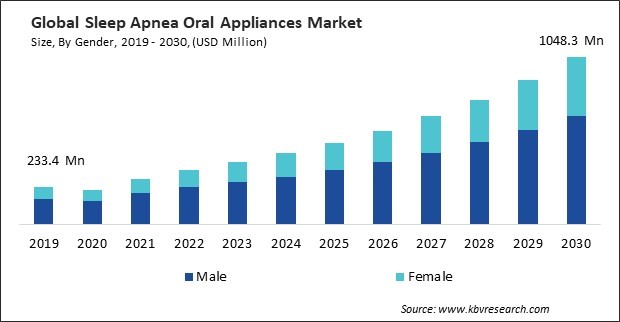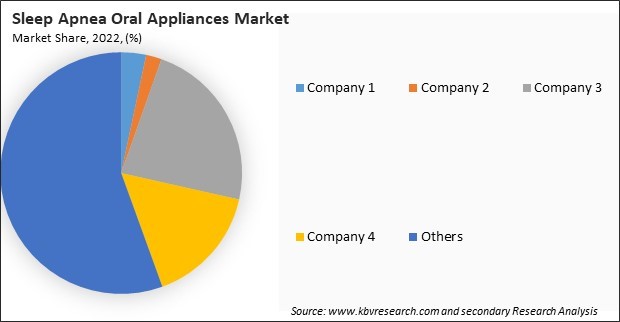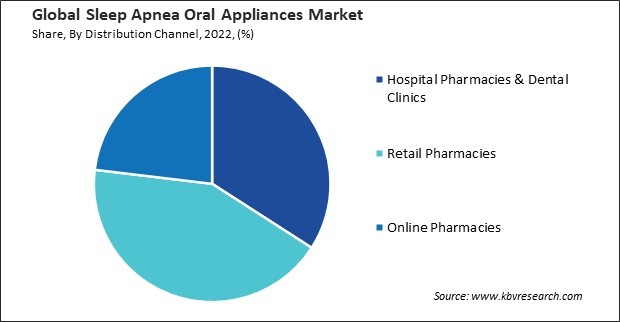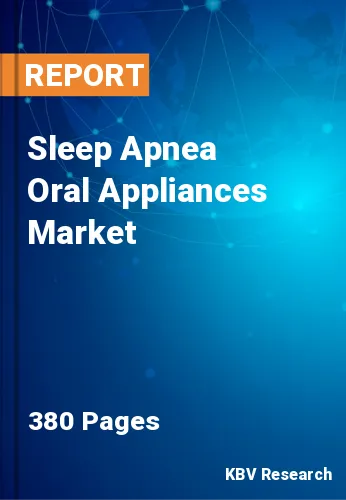“Global Sleep Apnea Oral Appliances Market to reach a market value of USD 1048.3 Million by 2030 growing at a CAGR of 15.2%”
The Global Sleep Apnea Oral Appliances Market size is expected to reach $1048.3 million by 2030, rising at a market growth of 15.2% CAGR during the forecast period.
As per the World Health Organization, one in six people will be 60 or older by 2030. The number of people 60 and older in the world will increase from 1 billion in 2020 to 1.4 billion in 2050. By 2050, there will be 2.1 billion people in the world who are 60 or older. It is anticipated that there will be 426 million persons 80 or older by 2050. Comorbid conditions like hypertension, diabetes, and cardiovascular disease are prevalent among the elderly and are associated with an increased risk of sleep apnea. Consequently, the above 60 years segment would acquire nearly 33% of the total market share by 2030. Cognitive loss and an increased risk of diseases like dementia are associated with sleep apnea. Managing sleep apnea with oral appliances may improve cognitive health outcomes in older people.

Lifestyle factors like sedentary behavior, obesity, and irregular sleep patterns contribute to the rise of sleep disorders. The link between lifestyle and sleep apnea increases the demand for accessible and lifestyle-compatible treatments like oral appliances. Excessive screen time, especially before bedtime, exposes individuals to blue light, which can disrupt the circadian rhythm and melatonin production. This disruption is linked to sleep disorders, and oral appliances become a relevant option for managing resulting sleep apnea. Thus, the market is expanding significantly due to the rise in lifestyle-related sleep disorders. Additionally, the collaboration between sleep specialists, dentists, and other healthcare professionals in a multidisciplinary approach to sleep medicine drives the adoption of oral appliances. This collaborative effort ensures a comprehensive evaluation and personalized treatment plans. With a multidisciplinary team, healthcare professionals often have a consensus regarding the efficacy and suitability of oral appliances. This expert agreement contributes to increased acceptance of oral appliances as a viable treatment option for sleep apnea. Hence, because of the increasing multidisciplinary approach to sleep medicine, the market is anticipated to increase significantly.
However, without standardized guidelines, there can be significant variability in the design and function of different oral appliances. This variability may result in differences in effectiveness among devices, making it challenging for healthcare professionals to predict or ensure optimal treatment outcomes. The absence of standardized criteria makes it difficult to compare research studies evaluating the efficacy of different oral appliances. This lack of comparability hinders the development of a robust evidence base and may slow down advancements in the field. Hence, lack of standardization in oral appliance design is a significant challenge that hampers the growth of market.
The pandemic disrupted global supply chains, affecting the production and distribution of medical devices, including these appliances. Delays in manufacturing, shortages of raw materials, and transportation disruptions potentially impacted the availability of these appliances. The pandemic led to a shift in research priorities, significantly emphasizing infectious diseases. This may impact the allocation of resources and attention to research and development in the market. Thus, the COVID-19 pandemic had a moderate effect on the market.

The leading players in the market are competing with diverse innovative offerings to remain competitive in the market. The above illustration shows the percentage of revenue shared by some of the leading companies in the market. The leading players of the market are adopting various strategies in order to cater demand coming from the different industries. The key developmental strategies in the market are Acquisitions, and Partnerships & Collaborations.
On the basis of gender, the market is bifurcated into male and female. The female segment garnered a significant revenue share in the market in 2022. Postmenopausal women may potentially experience hormonal fluctuations that are associated with an elevated susceptibility to sleep apnea. The recognition of this risk factor has led to a greater emphasis on addressing sleep apnea in women, particularly in the postmenopausal stage. Women's growing awareness of the importance of overall health and well-being motivates them to address sleep-related issues. Proactive health management includes seeking effective solutions for sleep apnea to enhance overall quality of life.
By product, the market is categorized into mandibular advancement devices, tongue-retaining devices, and daytime nighttime appliance. The tongue-retaining devices segment covered a considerable revenue share in the market in 2022. Tongue-retaining devices (TRDs) are an effective treatment option for mild to moderate obstructive sleep apnea. By holding the tongue forward, these devices help maintain an open airway, reducing the likelihood of obstruction and improving breathing during sleep. TRDs are effective in reducing or eliminating snoring. By preventing the tongue from collapsing backward and causing airway obstruction, these devices contribute to decreased airway resistance, reducing snoring.
By age group, the market is segmented into below 40 years, 40-60 years, and above 60 years. The above 60 years segment recorded a remarkable revenue share in the market in 2022. Sleep apnea becomes more prevalent with age, and older individuals are at an increased risk due to factors such as muscle tone loss, increased weight, and changes in airway anatomy. The higher incidence of sleep apnea in the above-60 age group drives the demand for effective treatment options. Oral appliances are known for their user-friendly design, making them suitable for older individuals. These devices' comfort and ease of use contribute to their appeal to individuals in the above-60 age group.
On the basis of distribution channel, the market is fragmented into online pharmacies, retail pharmacies, and hospital pharmacies & dental clinics. The online pharmacies segment covered a considerable revenue share in the market in 2022. Online pharmacies operate 24/7, allowing consumers to browse and purchase these appliances conveniently. This accessibility is particularly valuable for individuals with busy schedules or those seeking solutions outside regular business hours. Online platforms provide detailed information about these appliances, including product specifications, usage instructions, and customer reviews. This information enables consumers to make informed decisions regarding the products they select.

Based on purchase type, the market is classified into physician-prescribed/customized oral appliances and online OTC oral appliances. The online OTC oral appliances segment acquired a substantial revenue share in the market in 2022. Online OTC platforms provide consumers with direct access to a variety of oral appliances without the need for a prescription. This accessibility and convenience appeal to individuals seeking a straightforward solution for managing sleep apnea and related conditions. The online OTC oral appliances segment offers various devices catering to different preferences and needs. Consumers can explore various options and choose devices that align with their comfort preferences and specific sleep apnea conditions.
Based on end user, the market is divided into home care setting/ individuals, hospital, and dental clinics. The hospital segment acquired a substantial revenue share in the market in 2022. Hospitals facilitate collaboration between dentists and sleep specialists. Dentists specializing in dental sleep medicine can work alongside sleep specialists to recommend and prescribe oral appliances as a non-invasive treatment option. Hospitals can provide continuous monitoring and follow-up care for individuals using oral appliances. This ensures that the devices effectively manage sleep apnea, and adjustments can be made if necessary.
Free Valuable Insights: Global Sleep Apnea Oral Appliances Market size to reach USD 1048.3 Million by 2030
Region-wise, the market is analysed across North America, Europe, Asia Pacific, and LAMEA. In 2022, the North America region led the market by generating the highest revenue share. Collaboration between sleep specialists, dentists, and other healthcare professionals is becoming more common in North America. Healthcare providers in North America are increasingly educated about sleep apnea and its treatment options, including oral appliances. There is a heightened awareness of sleep apnea in North America, leading to an increased number of individuals seeking diagnosis and treatment.
| Report Attribute | Details |
|---|---|
| Market size value in 2022 | USD 341.1 Million |
| Market size forecast in 2030 | USD 1048.3 Million |
| Base Year | 2022 |
| Historical Period | 2019 to 2021 |
| Forecast Period | 2023 to 2030 |
| Revenue Growth Rate | CAGR of 15.2% from 2023 to 2030 |
| Number of Pages | 380 |
| Number of Tables | 599 |
| Report coverage | Market Trends, Revenue Estimation and Forecast, Segmentation Analysis, Regional and Country Breakdown, Market Share Analysis, Porter’s 5 Forces Analysis, Company Profiling, Companies Strategic Developments, SWOT Analysis, Winning Imperatives |
| Segments covered | Gender, Product, Age Group, Distribution Channel, Purchase Type, End User, Region |
| Country scope |
|
| Companies Included | SomnoMed Limited, ResMed, Inc., PROSOMNUS, INC., Apnea Sciences Corporation, Vivos Therapeutics, Inc, Open Airway Dental Solutions Australia Pty Ltd, Panthera Dental, Inc. (Panthera Sleep), Airway Management, Inc. and Ortho Solutions LC (DynaFlex) |
By Gender
By Product
By Age Group
By Distribution Channel
By Purchase Type
By End User
By Geography
The Market size is projected to reach USD $1048.3 million by 2030.
Rise in lifestyle-related sleep disorders are driving the Market in coming years, however,Lack of standardization in oral appliance design restraints the growth of the Market.
SomnoMed Limited, ResMed, Inc., PROSOMNUS, INC., Apnea Sciences Corporation, Vivos Therapeutics, Inc, Open Airway Dental Solutions Australia Pty Ltd, Panthera Dental, Inc. (Panthera Sleep), Airway Management, Inc. and Ortho Solutions LC (DynaFlex)
The expected CAGR of this Market is 15.2% from 2023 to 2030.
The 40-60 Years segment is generating the highest revenue in the Market by Age Group in 2022; thereby, achieving a market value of $518 Million by 2030.
The North America region dominated the Market by Region in 2022, and would continue to be a dominant market till 2030; thereby, achieving a market value of $338.3 Million by 2030.
Our team of dedicated experts can provide you with attractive expansion opportunities for your business.

 Drivers
Drivers
 Restraints
Restraints
